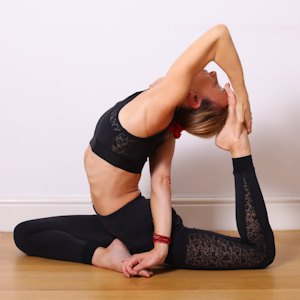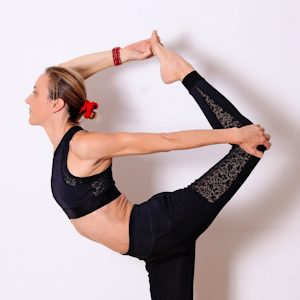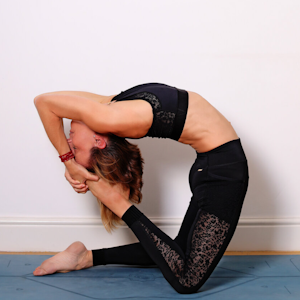Dharma yoga is a modern interpretation of classical eight-limbed or Hatha-Raja yoga. This practice is deeply rooted in several ethical principles and includes elements of flowing vinyasa, along with powerful inversions and held poses that encourage focus and concentration, meditation, inner peace, healing and deep relaxation.
Dharma yoga is firmly grounded in the earliest yogic principles. The practice was named after its creator, yoga master, Sri Dharma Mittra, whose renowned photographic representations, Master Chart of 908 Asanas has become an essential yoga resource.
What Does Dharma Yoga Involve?
As well as focusing on physical postures (asanas), Dharma yoga also regards other practices such as breathing exercises (pranayama) deep meditation, and service to others as essential to the practice. The study of yogic texts and an understanding of yogic philosophy are also included, and Dharma yoga emphasises moral and ethical living as essential attitudes on the path to spiritual enlightenment.
The Underlying Philosophy of Dharma Yoga
The essential philosophy behind Dharma yoga is ahimsa, which roughly translates as non-violence, love and compassion. In Dharma yoga, we maintain an awareness of yogic philosophy and strive to become kinder, better human beings. Without this essentially peaceful mindset, according to some yogic scholars, yoga asanas are a purely physical exercise.
The Challenge and Rewards of Dharma Yoga
Dharma yoga is based on classical hatha yoga disciplines, which encourage both spiritual and physical mastery. This comes through challenging the body quite deeply, from the beginner’s stage right through to the very advanced postures. Because of this challenge, and the opportunity for gradual progression, it is endlessly interesting, rewarding, and even fun!



Eight Key Dharma Yoga Asanas
There are 8 main poses that make up the dharma yoga practice. These central asanas then branch out into a further 32, then 84 and so on.
The 8 main poses are headstand, shoulder stand, fish pose, forward bend, backbend, spinal twist, shavasana, and seated pose.
1. Sirshasana (Inversion on the Head)
Sirshasana (headstand), is an advanced inversion posture. Sri Dharma Mittra famously stands on his head without the use of his hands (niralamba sirshasana). There are also variations to this asana, for example, one-handed headstand and headstand with arms extended forward.
When practicing this advanced headstand posture, the heart is above the head, which makes it an excellent posture for the brain, the heart, and the nervous system. It is best practiced under supervision and is not recommended for those with high blood pressure.
Sirshasana is said to increase blood flow, improve concentration, and stimulate the pituitary gland. It also calms the mind, settles the nervous system, strengthens the heart and improves circulation and nerve function.
2. Sarvangasana (Candle)
Sarvangasana is a great way to improve your flexibility and balance and can also help to strengthen your core muscles.
To perform this posture, lie on your back with your legs extended.
Slowly extend your legs and torso towards the ceiling, keeping your back straight. Once you have achieved the position, hold for a few seconds before slowly lowering yourself down.
Candle pose is one of the most popular yoga poses.
3. Matsyasana (Fish Pose)
Fish Pose is a wonderfully soothing stretch for the entire body. By raising the chin and neck, we are able to extend the spine and create a deeply rejuvenating flexion. While practising this pose, we expand the chest, neck, back, abs and hip flexors. Fish pose allows us to stretch into parts of the body that are sometimes neglected.
Dharma Mittra constantly reminds us that headstand, shoulder stand, and fish pose are 3 of the most important of all asanas – the father, the mother and the baby – and should always be practised together.
4. Uttanasana (Forward Bend)
Uttanasana is a powerful standing yoga pose that provides many benefits related to strength and flexibility. This calming and rejuvenating posture helps to open the hips whilst also stretching the spine, hamstrings, and calf muscles. It soothes the mind and provides a deep stretch through the entire body.
5. Backbend
We typically practise many backbends in Dharma yoga classes. Among these is the cobra asana (Bhujangasana). There is a famous saying by Dharma Mittra, “If experiencing insomnia, do 6 rounds of cobra before going to bed.”
To perform cobra, start by lying on your stomach with your chin on the floor.
Place your hands on the floor next to your chest, with your palms facing down.
Extend your torso upwards whilst arching your back, keeping your feet and legs on the ground. Hold the pose for a few seconds. Slowly release and return to the starting position.
Cobra helps to open the chest, improve spinal flexibility and strengthen the arms and back muscles.
6. Spinal Twist (Ardha Matsyendrasana)
Dharma describes this as one of the most important seated twists, the one from which all other spinal twists evolved.
Start by sitting on the ground with your legs straight out in front of you. Slowly bend your right knee and position your right foot on the ground next to your left knee. Place your left hand on the ground behind you, and twist your torso slowly to the right, placing your right hand firmly on the ground next to your right hip. Hold this stretching position for a few breaths, release, and repeat on the other side.
This twist is said to be beneficial for the digestive system and can help to relieve gas and bloating. It is also believed to help increase flexibility in the spine.
7. Shavasana
Guided deep healing and relaxation (yoga nidra) is another element of Dharma yoga. Shavasana is a beautifully soothing, relaxing, and gentle asana that helps to relieve stress, slow the thoughts and recharge the physical body.
8. Seated Posture (Padmasana)
Sit upright with your legs folded inward and each foot resting on the opposite thigh, palms resting gently on the thighs. You should start to feel a deep sense of relaxation and peace within your body and mind.
Focus on the breath and allow this relaxed pose to open the heart and unlock the body’s vital energy, allowing it to flow freely and dynamically. The seated lotus position is wonderful for beginners, as it is uncomplicated and helps to open up the hips and stretch the legs.
Dharma Mittra says that any asana practiced in lotus pose, for example, headstand or shoulder stand, becomes more powerful, as it helps to calm the mind.
Why Choose Dharma Yoga?
Dharma Yoga is a powerful and transformative practice that helps to create a deeper connection between mind, body and spirit. It is a complete practice that leads to radiant health, a peaceful mind and, ultimately, self-realisation. It is traditional yet contemporary and provides the perfect practice for today’s fast-paced world, regardless of age, background or level of ability.
An explorative practice, Dharma Yoga is an opportunity to go deeper. Where Power Yoga strengthens and grounds, Dharma Yoga opens and elevates. With a focus on heart opening, you are encouraged to find areas of resistance, and refine and work on your asana, with variations for each pose. Exploration and expansion of your physical practice with Dharma Yoga will enhance your Power Yoga practice.
Practice Dharma Yoga with The Power Yoga Company!
If you want to deepen your yoga practice and connect with inner wisdom and peace, Dharma yoga may be the perfect choice for you.
The Power Yoga Company is an established yoga studio in London that currently offers weekly Dharma yoga classes led by Alix Inness. Book your classes now and enjoy its life-enhancing benefits!